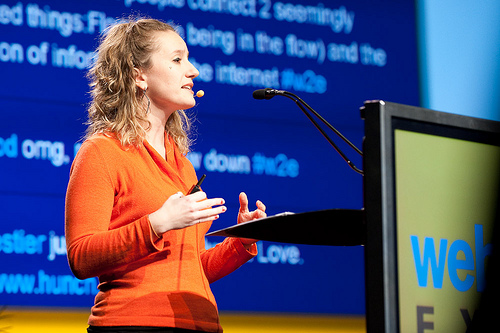Under the Bright Lights

Fellow Digital Media and Learning blogger danah boyd recently described a public speaker's worst nightmare scenario in the era of Web 2.0. As boyd explains in "spectacle at Web2.0 Expo... from my perspective," Twittering members of the audience derailed her talk with publicly visible snarkiness that rattled her nerves at the podium.
I think that the backchannel is perfectly reasonable as a frontchannel when the speaker is trying to entertain, but when the goal is to convey something with depth, it encourages people to be impatient and frustrated, to feed on the speaker. There's a least common denominator element to it. I was not at Web2.0 Expo to entertain, but to inform. Yes, I can be an entertaining informant, but there's a huge gap between the kind of information that Baratunde tries to convey in his comedic format and what I'm trying to convey in a more standard one. And there's no doubt I packed too much information into a 20 minute talk, but my role is fundamentally to challenge audiences to think. That's the whole point of bringing a scholar to the stage. But if the audience doesn't want to be challenged, they tune out or walk out. Yet, with a Twitter stream, they have a third option: they can take over.
The problem with a public-facing Twitter stream in events like this is that it FORCES the audience to pay attention the backchannel. So even audience members who want to focus on the content get distracted. Most folks can't multitask that well. And even if I had been slower and less dense, my talks are notoriously too content-filled to make multi-tasking possible for the multi-tasking challenged. This is precisely why I use very simplistic slides that evokes images for the visual types in the room without adding another layer of content. But the Twitter stream fundamentally adds another layer of content that the audience can't ignore, that I can't control. And that I cannot even see.
Now, I'm AOK with not having complete control of the audience during a talk, but it requires a fundamentally different kind of talk. That was not what I prepared for at all. Had I known about the Twitter stream, I would've given a more pop-y talk that would've bored anyone who has heard me speak before and provided maybe 3-4 nuggets of information for folks to chew on. It would've been funny and quotable but it wouldn't have been content-wise memorable. Perhaps that would've made more sense? Realistically though, those kinds of talks bore me at this point. So I probably would've opted not to give a talk at all. Perhaps I'm not the kind of speaker you want if you want a Twitter stream? But regardless, what I do know is that certain kinds of talks do not lend themselves to that kind of dynamic. I would *NEVER* have given my talk on race and class in such a setting. I shudder to think about how the racist language people used when I gave that talk would've been perceived on the big screen.
I suspect that these kinds of more public backchannels may be here to stay at academic conferences. I know from my own talks, that seeing the critical responses of live bloggers and status updaters can be disconcerting, so I'd probably rather keep myself unaware of those exchanges at the moment of performance whenever I can.From a rhetorical perspective, this conflict between traditional oratory and the text message is interesting, of course, but I suspect this won't be the last story about it.
Thanks to Vivian Folkenflik for the link.
Labels: conferences, social networking

1 Comments:
Given her feelings on the matter, I think she should, definitely, stay away from the Apollo.
Post a Comment
<< Home